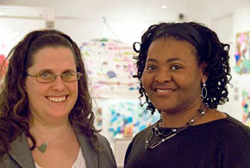Using Data from Space to Help Instruction in the Classroom
TC teams up with NASA to offer new certificate in Science Education
For decades, schoolchildren studying earth science have built papier-mâché volcanoes, painted them rock-colored, poured in vinegar and baking soda, and gleefully watched them erupt. Now Julie Gabrovic, a science teacher in Longwood , Florida
Gabrovic, a science teacher for grades kindergarten through five in Longwood , Florida , is a participant in NASA’s Endeavor Science Teaching Certificate Project, a collaboration with Teachers College’s Urban Science Education Center
The Endeavor program guides teachers to information that “some teachers just wouldn’t know, unless you’re really researching and hunting all the time,” Gabrovic says. “We looked at volcanoes on Mars, and compared and contrasted the sizes and location on Mars versus volcanoes on Earth. The students are super-excited about the science.” She also uses Google Mars to allow students and teachers to visually “travel across the surface of Mars using real footage, not a model.”
Working with Felicia Moore Mensah, Assistant Professor of Science Education at TC; and Meghan Marrero, a TC doctoral graduate who works at U.S. Satellite and is an adjunct Assistant Professor of Science Education at TC, a select group of teachers across the country participate in workshops and take online and on-site graduate courses.
At the end of a fellowship that lasts from 18 months to two years, participants earn a Certificate of Completion in Applied Science Education from Teachers College and graduate credit from other institutional partners. Most can apply credit from the project courses toward state certification requirements. There were 40 fellows last year, the first year of the program, and another 40 this year. NASA hopes to put 200 in-service and pre-service teachers through the competitive program over five years. According to NASA’s Web site, “the goal of the project is to ensure that teachers across the country can use the discoveries that NASA makes on a daily basis to inspire the next generation of explorers, scientists, engineers, and astronauts.”
The program works on multiple levels. Endeavor Fellows complete a minimum of five online graduate-level “short courses” which are interdisciplinary, including life and marine science, math connections to earth and space science. Fellows also take methods in STEM education and an action research course. The courses are taught by Marrero and other TC affiliated faculty, Jessica Riccio and Amanda Gunning. Classes are live, online sessions in which fellows participate on the telephone and the Internet at the same time. Marrero and Glen Schuster, the project director at U.S. Satellite, also arrange for special online guest lectures by experts in a variety of fields—including NASA scientists and engineers.
As program members, Fellows can log on to a U.S. Satellite Web site and share information as part of an online community, a feature Gabrovic has found particularly valuable. “I have developed units and lesson plans using
information from the Web sites,” she says, adding that she hopes to maintain contact with Fellows after she finishes her program this summer.
U.S. Satellite, in Rye , N.Y. , a STEM education and professional development company for educators, provides the platform for “an online community in which they come together and share experiences, tips and information,” Marrero says. “It is very interesting to watch that community. It starts out not very well used, but as the teachers get to know each other online, they start sharing lessons and resources, asking questions. I am presenting some preliminary research on this at an upcoming science education conference.”
From the time they apply to the program, Endeavor fellows are committed to sharing what they have learned with teachers in their schools and school districts. Gabrovic, for example, reports monthly to a district-wide leadership committee for science and math.
The project also provides workshops and research opportunities for science education professors at schools of education. “I think the Endeavor program has great potential for anybody who wants to work in research around professional development for K–12 education” says Moore Mensah. “I have two colleagues in Alabama and Kentucky
The goal is to train more science teachers, first at the elementary level and then at the junior-high and high school levels. Moore Mensah also would like to inspire more minority students to pursue STEM studies. In order to do so, “we have to prepare well-qualified and enthusiastic teachers at the elementary level,” she says. “We really want all students, and especially students traditionally marginalized from full participation in science, to get involved in STEM disciplines, to see that they can be scientists, and to see that science is enjoyable to learn. The route to getting there is to set a strong foundation at the elementary science level,” says Moore Mensah.
That has been the outcome for the students of Carolyn Stiles, a NASA Endeavor fellow and fourth-grade teacher at Hillsboro-Deering Elementary School in Hillsboro , New Hampshire
Stiles says that, at her school, science instruction isn’t all that has benefited from her NASA fellowship. In a push to raise the school’s NCLB rating, which relies heavily on reading and math scores, she has woven the information into math and literacy classes and begun to share her experience with other teachers at her school. “I just hope that through science we can transform our school,” she says.
A similar transformation is in the works in the third-grade classroom of Natash Jones at Martin Luther King, Jr. elementary school in Published Monday, May. 10, 2010
